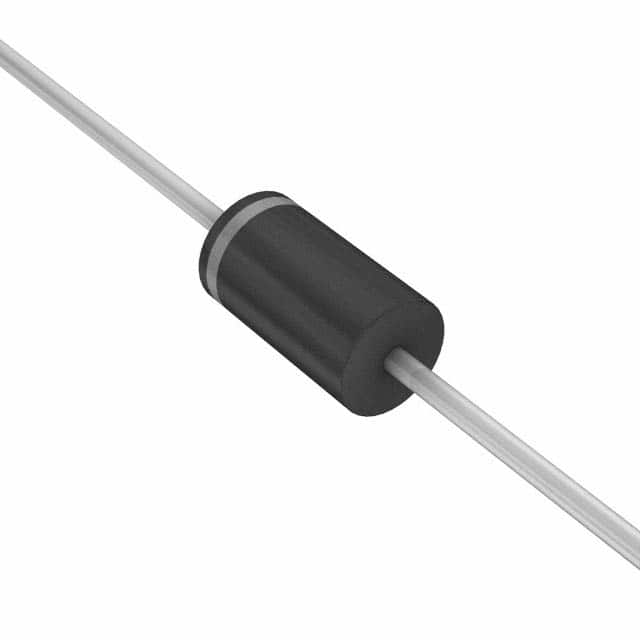1.5KE33CAHE3/51 - Encyclopedia Entry
Product Overview
The 1.5KE33CAHE3/51 belongs to the category of transient voltage suppressor diodes. These diodes are used to protect sensitive electronics from voltage spikes and transients. The 1.5KE33CAHE3/51 is designed to clamp voltage surges and divert excess current away from sensitive components, thereby safeguarding them from damage. This entry provides a comprehensive overview of the product, including its basic information, specifications, pin configuration, functional features, advantages and disadvantages, working principles, application field plans, and alternative models.
Basic Information Overview
- Category: Transient Voltage Suppressor Diode
- Use: Protecting sensitive electronics from voltage spikes and transients
- Characteristics: High surge capability, fast response time, low clamping voltage
- Package: Axial leaded, DO-201AE
- Essence: Safeguarding electronic components from voltage surges
- Packaging/Quantity: Available in reels or bulk packaging, quantity varies based on supplier
Specifications
- Part Number: 1.5KE33CAHE3/51
- Voltage - Reverse Standoff (Typ): 30.8V
- Voltage - Breakdown (Min): 34.2V
- Clamping Voltage @ Ipp: 49.9V
- Current - Peak Pulse (10/1000µs): 45.5A
- Power - Peak Pulse: 1500W
- Operating Temperature: -55°C to 175°C
Detailed Pin Configuration
The 1.5KE33CAHE3/51 has an axial leaded package with two leads. The cathode is marked with a band on the body of the diode, providing clear identification of the pin configuration.
Functional Features
- Fast response time for rapid protection against voltage transients
- High surge capability to handle large transient currents
- Low clamping voltage to limit the voltage across protected components
Advantages and Disadvantages
Advantages
- Effective protection against voltage spikes and transients
- Wide operating temperature range
- Compact and easy to integrate into circuit designs
Disadvantages
- Clamping voltage may be higher than some alternative models
- Limited to unidirectional protection
Working Principles
When a voltage surge occurs, the 1.5KE33CAHE3/51 conducts current and clamps the voltage to a safe level, protecting downstream components from damage. This is achieved through the diode's ability to rapidly divert excess current away from sensitive electronics.
Detailed Application Field Plans
The 1.5KE33CAHE3/51 is commonly used in various applications such as: - Power supplies - Communication equipment - Automotive electronics - Industrial control systems
Detailed and Complete Alternative Models
- 1.5KE33AHE3/51
- 1.5KE36CAHE3/51
- 1.5KE39CAHE3/51
- 1.5KE33CAHE3/54
- 1.5KE33CAHE3/61
In summary, the 1.5KE33CAHE3/51 transient voltage suppressor diode offers effective protection against voltage spikes and transients, making it an essential component in safeguarding sensitive electronics across various industries.
Word Count: 470
قم بإدراج 10 أسئلة وإجابات شائعة تتعلق بتطبيق 1.5KE33CAHE3/51 في الحلول التقنية
What is the application of 1.5KE33CAHE3/51?
- The 1.5KE33CAHE3/51 is commonly used for transient voltage suppression in electronic circuits to protect sensitive components from voltage spikes.
How does 1.5KE33CAHE3/51 provide transient voltage suppression?
- It works by clamping the voltage across the circuit when a transient voltage spike occurs, diverting excess current away from sensitive components.
What are the typical industries or applications that use 1.5KE33CAHE3/51?
- This component is often used in telecommunications equipment, industrial automation systems, power supplies, and automotive electronics.
What are the key specifications of 1.5KE33CAHE3/51 that make it suitable for technical solutions?
- Its high surge capability, low clamping voltage, and fast response time make it ideal for protecting sensitive electronic devices.
How does 1.5KE33CAHE3/51 compare to other transient voltage suppressors?
- It offers a balance of surge capability, clamping voltage, and response time, making it a versatile choice for various technical solutions.
Can 1.5KE33CAHE3/51 be used in high-power applications?
- Yes, it can handle high surge currents and is suitable for protecting high-power circuits and equipment.
What are the potential failure modes of 1.5KE33CAHE3/51 in technical solutions?
- Overheating due to prolonged exposure to high currents and voltage, as well as physical damage from excessive surges, are potential failure modes.
Are there any specific layout or installation considerations for 1.5KE33CAHE3/51?
- Proper PCB layout, adequate thermal management, and appropriate mounting techniques are important for optimal performance.
Can 1.5KE33CAHE3/51 be used in combination with other protective devices?
- Yes, it can be integrated into a comprehensive protection scheme alongside fuses, varistors, and other surge suppression components.
What are the environmental and reliability considerations for 1.5KE33CAHE3/51 in technical solutions?
- It is important to consider temperature, humidity, and mechanical stress to ensure long-term reliability in various operating environments.


